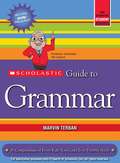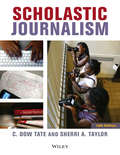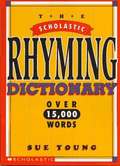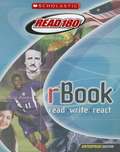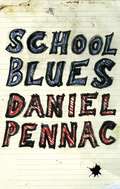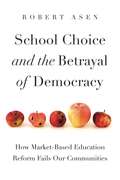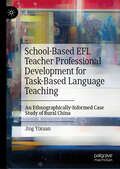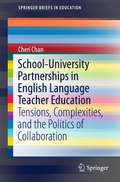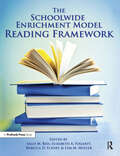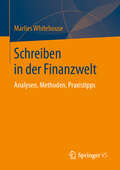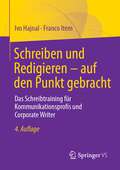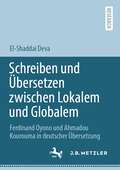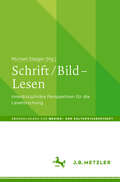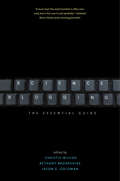- Table View
- List View
Scholastic Dictionary of Spelling
by Marvin Terban Harry CampbellThe revised SCHOLASTIC DICTIONARY OF SPELLING has been updated with 1,000 new words and an all-new design that will make it the choice for young writers to turn to for an instant spell-check. With a brand new design, 1,000 additional words, and new fun sections like "The Four Longest Words in the English Language" and "The Spelling Words That Made Kids Champions," this is the perfect spelling resource for students. The introduction gives instructions for looking up a word the reader does not necessarily know how to spell, offers more than 150 memory tricks to correct commonly misspelled words, and clearly explains general spelling rules (and their exceptions). Furthermore, to aid pronunciation, each word is divided into syllables with the accented syllable in boldface.
Scholastic Guide to Grammar
by Marvin TerbanThe ultimate resource for proper grammar. The Scholastic Guide to Grammar is an easy-to-use, color-coded, tabbed guide packed full of information, examples, and tips for English language arts success. Write a paper, meet new people, apply for a job, and more, with perfect grammar, spelling, and punctuation. Join "Professor Grammar" on this guided journey through the intricacies of the English language.
Scholastic Journalism
by Sherri A. Taylor C. Dow TateThe new 12th edition of Scholastic Journalism is fully revised and updated to encompass the complete range of cross platform multimedia writing and design to bring this classic into the convergence age.Incorporates cross platform writing and design into each chapter to bring this classic high school journalism text into the digital ageDelves into the collaborative and multimedia/new media opportunities and changes that are defining the industry and journalism education as traditional media formats converge with new technologiesContinues to educate students on the basic skills of collecting, interviewing, reporting, and writing in journalismIncludes a variety of new user-friendly features for students and instructorsFeatures updated instructor manual and supporting online resources, available at www.wiley.com/go/scholasticjournalism
Scholastic rBook, Flex
by ScholasticA student workbook that provides instruction in reading comprehension, vocabulary, and writing and grammar skills.
School Blues
by Daniel PennacDaniel Pennac has never forgotten what it was like to be a very unsatisfactory student, nor the day one of his teachers saved his life by assigning him the task of writing a novel. This was the moment Pennac realized that no-one has to be a failure for ever. In School Blues, Pennac explores the many facets of schooling: how fear makes children reject education; how children can be captivated by inventive thinking; how consumerism has altered attitudes to learning. Haunted by memories of his own turbulent time in the classroom, Pennac enacts dialogues with his teachers, his parents and his own students, and serves up much more than a bald analysis of how young people are consistently failed by a faltering system. School Blues is not only universally applicable, but it is unquestionably a work of literature in its own right, driven by subtlety, sensitivity and a passion for pedagogy, while embracing the realities of contemporary culture.
School Blues
by Daniel PennacDaniel Pennac has never forgotten what it was like to be a very unsatisfactory student, nor the day one of his teachers saved his life by assigning him the task of writing a novel. This was the moment Pennac realized that no-one has to be a failure for ever. In School Blues, Pennac explores the many facets of schooling: how fear makes children reject education; how children can be captivated by inventive thinking; how consumerism has altered attitudes to learning. Haunted by memories of his own turbulent time in the classroom, Pennac enacts dialogues with his teachers, his parents and his own students, and serves up much more than a bald analysis of how young people are consistently failed by a faltering system. School Blues is not only universally applicable, but it is unquestionably a work of literature in its own right, driven by subtlety, sensitivity and a passion for pedagogy, while embracing the realities of contemporary culture.
School Choice and the Betrayal of Democracy: How Market-Based Education Reform Fails Our Communities (Rhetoric and Democratic Deliberation #26)
by Robert AsenEvidence shows that the increasing privatization of K–12 education siphons resources away from public schools, resulting in poorer learning conditions, underpaid teachers, and greater inequality. But, as Robert Asen reveals here, the damage that market-based education reform inflicts on society runs much deeper. At their core, these efforts are antidemocratic.Arguing that democratic communities and public education need one another, Asen examines the theory driving privatization, popularized in the neoliberalism of Milton and Rose Friedman, as well as the case for school choice promoted by former secretary of education Betsy DeVos and the controversial voucher program of former Wisconsin governor Scott Walker. What Asen finds is that a market-based approach holds not just a different view of distributing education but a different vision of society. When the values of the market—choice, competition, and self-interest—shape national education, that policy produces individuals, Asen contends, with no connections to community and no obligations to one another. The result is a society at odds with democracy.Probing and thought-provoking, School Choice and the Betrayal of Democracy features interviews with local, on-the-ground advocates for public education and offers a countering vision of democratic education—one oriented toward civic relationships, community, and equality. This book is essential reading for policymakers, advocates of public education, citizens, and researchers.
School Choice and the Betrayal of Democracy: How Market-Based Education Reform Fails Our Communities (Rhetoric and Democratic Deliberation)
by Robert AsenEvidence shows that the increasing privatization of K–12 education siphons resources away from public schools, resulting in poorer learning conditions, underpaid teachers, and greater inequality. But, as Robert Asen reveals here, the damage that market-based education reform inflicts on society runs much deeper. At their core, these efforts are antidemocratic.Arguing that democratic communities and public education need one another, Asen examines the theory driving privatization, popularized in the neoliberalism of Milton and Rose Friedman, as well as the case for school choice promoted by former secretary of education Betsy DeVos and the controversial voucher program of former Wisconsin governor Scott Walker. What Asen finds is that a market-based approach holds not just a different view of distributing education but a different vision of society. When the values of the market—choice, competition, and self-interest—shape national education, that policy produces individuals, Asen contends, with no connections to community and no obligations to one another. The result is a society at odds with democracy.Probing and thought-provoking, School Choice and the Betrayal of Democracy features interviews with local, on-the-ground advocates for public education and offers a countering vision of democratic education—one oriented toward civic relationships, community, and equality. This book is essential reading for policymakers, advocates of public education, citizens, and researchers.
School-Based EFL Teacher Professional Development for Task-Based Language Teaching: An Ethnographically-Informed Case Study of Rural China
by Jing YixuanThis book investigates the efficacy of a teacher educator collaborating with rural Chinese teachers of English to activate agentic adoption of task-based language teaching (TBLT). Set in rural northwestern China, the book traces the researcher's role as a participant-observer, during which she conducted a 12-week immersive study in a rural secondary school. The initial approach focused on understanding and trust-building, followed by the development of a collaborative partnership with teachers, and results demonstrate that given appropriate guidance and assistance, rural Chinese teachers successfully incorporated tasks into their classrooms to encourage increased motivation for learning and communicating in English. This book will be of interest to students and scholars of applied linguistics, language education, and TESOL, and the author demonstrates that true teacher educators are more effective as learning partners to teachers than simply a coach or lecturer.
School-University Partnerships in English Language Teacher Education
by Cheri ChanThis book addresses the complex issues that arise in school-university collaborative action research projects. Employing sociocultural perspectives on examining professional practices of in-service teachers, it examines the complexities of negotiating beliefs, identities and interpersonal relations when educators from two different institutional cultures collaborate. Specifically, the book explores issues such as the discourses that are operative in school-university collaboration for English language teacher education; the way in which beliefs, interpersonal relations and identities are negotiated in school-university partnership; what tensions and complexities operate in collaborative action research discourse in an educational context; and how school-university collaboration can be achieved. The book adopts a critical perspective and provides arguments from a non-Western sociocultural perspective.
Schooling in Modernity
by Paola BonifazioBetween 1948 and the end of the 1950s, Italian and American government agencies and corporations commissioned hundreds of short films for domestic and foreign consumption on topics such as the fight against unemployment, the transformation of rural and urban spaces, and the re-establishment of democratic regimes in Italy and throughout Europe. In Schooling in Modernity, Paola Bonifazio investigates the ways in which these sponsored films promoted a particular vision of modernization and industry and functioned as tools to govern the Italian people.The author uses extensive archival research and various theoretical approaches to examine the politics of sponsored filmmaking in postwar Italy. Among the many topics explored are target audiences and audience response, sources of funding, censorship, debates on cinematic realism, and the connections and differences between American and Italian strategies and styles of documentary filmmaking. Insightful and richly detailed, Schooling in Modernity shows the importance of these under-appreciated films in the postwar modernization process, the transition from Fascism to democracy, and Italy's involvement in the Cold War.
Schoolwide Enrichment Model Reading Framework
by Sally M. Reis Rebecca D. Eckert Elizabeth A. Fogarty Lisa M. MullerBased on research conducted by The National Research Center on the Gifted and Talented, this guidebook presents a framework for increasing reading achievement, fluency, and enjoyment. The Schoolwide Enrichment Model Reading Framework (SEM-R) focuses on enrichment for all students through engagement in challenging, self-selected reading, accompanied by instruction in higher order thinking and strategy skills. A second core focus of the SEM-R is differentiating instruction and reading content, coupled with more challenging reading experiences and advanced opportunities for metacognition and self-regulated reading. Chapters cover each of the three phases of the framework, implementation variations, and organization strategies, and the appendices provide handouts, booklists, charts, and more.
Schopenhauer and the Aesthetic Standpoint
by Sophia VasalouWith its pessimistic vision and bleak message of world-denial, it has often been difficult to know how to engage with Schopenhauer s philosophy. His arguments have seemed flawed and his doctrines marred by inconsistencies; his very pessimism almost too flamboyant to be believable. Yet a way of redrawing this engagement stands open, Sophia Vasalou argues, if we attend more closely to the visionary power of Schopenhauer s work. The aim of this book is to place the aesthetic character of Schopenhauer s standpoint at the heart of the way we read his philosophy and the way we answer the question: why read Schopenhauer - and how? Approaching his philosophy as an enactment of the sublime with a longer history in the ancient philosophical tradition, Vasalou provides a fresh way of assessing Schopenhauer s relevance in critical terms. This book will be valuable for students and scholars with an interest in post-Kantian philosophy and ancient ethics.
Schreiben Sie Charaktere Menschen Schaffen, Die Die Leser Lieben Werden: Schreiben Sie Charaktere Menschen Schaffen, Die Die Leser Lieben Werden
by Susan PalmquistSchreiben Sie Charaktere Menschen Schaffen, Die Die Leser Lieben Werden Es ist nicht immer die handlung, die den lesern am meisten an Ihrem buch in erinnerung bleibt, sondern eine oder mehrere Figuren, die ihre aufmerksamkeit fesseln; hält ihr Interesse aufrecht und zwingt sie, weiterzulesen, um herauszufinden, was passiert.
Schreiben in der Finanzwelt: Analysen, Methoden, Praxistipps
by Marlies WhitehouseDas Buch erfasst zuerst den komplexen und dynamischen Kontext, in dem Schreiben in der Finanzwelt geschieht, und untersucht dann am Beispiel einer zentralen Textsorte, was diese Textprodukte tatsächlich leisten. Schließlich entwickelt das Buch forschungsbasierte Werkzeuge, die den Kommunikationserfolg von Finanztexten systematisch und wirksam verbessern können.
Schreiben und Redigieren – auf den Punkt gebracht: Das Schreibtraining für Kommunikationsprofis und Corporate Writer
by Ivo Hajnal Franco ItemDas Buch bietet professionellen Schreiberinnen und Schreibern praxisnahe Anregungen, eigene wie fremde Texte zu optimieren. Ein professioneller Sprachgebrauch hält sich an klare, objektive Vorgaben. Dementsprechend beruht dieses Buch auf empirischen Daten zur Verständlichkeit von Unternehmens- und Medientexten, die in eine leicht umzusetzende Checkliste münden.
Schreiben und Übersetzen zwischen Lokalem und Globalem: Ferdinand Oyono und Ahmadou Kourouma in deutscher Übersetzung
by El-Shaddai DevaÜbersetzer*innen afrikanischer Autoren im deutschen Sprachraum werden oft eurozentrische, kolonialistische und rassistische Absichten unterstellt. Über die Analyse deutscher Übersetzungen ausgewählter Romane von Ferdinand Oyono und Ahmadou Kourouma zeigt El-Shaddai Deva in diesem Buch, dass dies meist zu Unrecht geschieht, da diese Vermittler*innen der afrikanischen Literatur allgemein eine besondere Liebe für den Kontinent, seine Menschen und Kulturen zeigen. Ihre advokatische Haltung geht allerdings mit einer Auffassung der afrikanischen Literatur als Zeitdokument und als Informationsquelle einher. Eine solche Auffassung übt letzten Endes einen Einfluss auf die Ausrichtung der Übersetzung aus: übersetzt wird nicht die Poetik der Originale, sondern ausschließlich deren Inhalt; nicht die lebende Sprache, sondern nur das sprachliche Werkzeug.
Schrift / Bild – Lesen: Interdisziplinäre Perspektiven für die Leseforschung (Abhandlungen zur Medien- und Kulturwissenschaft)
by Michael StaigerIm Zuge der gegenwärtigen Transformation hin zu einer digitalen, multimodal dominierten Medienkultur vollzieht sich ein Wandel des Lesens. Dieser betrifft nicht nur die Lesemedien und die Rezeptionsbedingungen, sondern auch die Medialität und Materialität von Texten. Im Mittelpunkt des Bandes steht die Frage, wie Texte gelesen werden, die Schrift und Bilder miteinander kombinieren. Vorgestellt werden Zugänge aus den Literatur-, Buch- und Medienwissenschaften, aus der Multimodalitätsforschung und Kognitionspsychologie sowie aus Kunstwissenschaft und Deutschdidaktik. Ziel ist es, das Forschungsfeld des Schrift-Bild-Lesens abzustecken und einen Beitrag zu seiner theoretischen Grundlegung zu leisten.
Schumann’s Music and E. T. A. Hoffmann’s Fiction
by John MacauslanFour of Schumann's great masterpieces of the 1830s - Carnaval, Fantasiestücke, Kreisleriana and Nachtstücke - are connected to the fiction of E. T. A. Hoffmann. In this book, John MacAuslan traces Schumann's stylistic shifts during this period to offer insights into the expressive musical patterns that give shape, energy and individuality to each work. MacAuslan also relates the works to Schumann's reception of Bach, Beethoven, Novalis and Jean Paul, and focuses on primary sources in his wide-ranging discussion of the broader intellectual and aesthetic contexts. Uncovering lines of influence from Schumann's reading to his writings, and reflecting on how the aesthetic concepts involved might be used today, this book transforms the way Schumann's music and its literary connections can be understood and will be essential reading for musicologists, performers and listeners with an interest in Schumann, early nineteenth-century music and German Romantic culture.
Science Blogging
by Bethany Brookshire Christie Wilcox Jason G. GoldmanHere is the essential how-to guide for communicating scientific research and discoveries online, ideal for journalists, researchers, and public information officers looking to reach a wide lay audience. Drawing on the cumulative experience of twenty-seven of the greatest minds in scientific communication, this invaluable handbook targets the specific questions and concerns of the scientific community, offering help in a wide range of digital areas, including blogging, creating podcasts, tweeting, and more. With step-by-step guidance and one-stop expertise, this is the book every scientist, science writer, and practitioner needs to approach the Wild West of the Web with knowledge and confidence.

